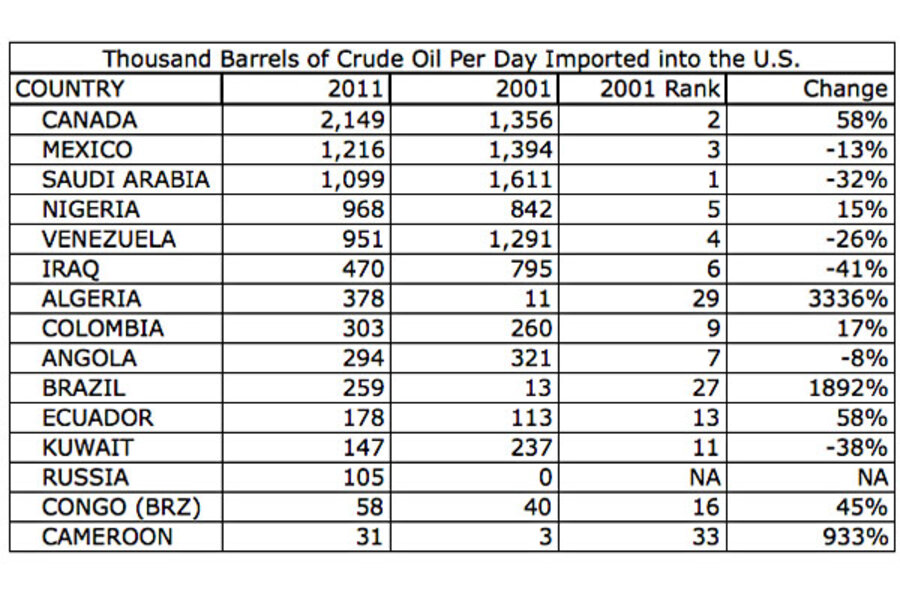Top 15 sources of US crude oil imports
Loading...
The Energy Information Administration (EIA) recently published an article on 2011 U.S. crude oil imports. I thought it might be interesting to take a look at where the U.S. currently obtains its oil, and how that has changed over the past decade. The EIA story is: Nearly 69% of U.S. crude oil imports originated from five countries in 2011. I downloaded their data sources for 2011 import data, and then also went into the archives and pulled up 2001 import data to create the above table.
Canada is Our Most Important Supplier
Over the past decade, Canada became our top supplier of oil, largely due to increases in oil sands production. The EIA report noted that U.S. imports from Canada topped 2 million barrels per day for the first time ever in 2011, “because more oil is now being transported by rail.” This is one of the reasons that the Keystone XL pipeline protests may have the opposite effect of what the protesters intend. Lack of pipeline access isn’t going to slow the growth of the oil sands much (Canadian crude oil imports were up 12% in 2011), it just forces more oil onto more carbon intensive transport options (and perhaps to more distant destinations). Note that there is also greater risk from transporting oil via rail versus pipeline.
Saudi Arabia declined in importance as a supplier of oil to the U.S. over the decade, falling from the top supplier in 2001 to the third spot last year. Imports from Mexico were down 13% over the decade, but Mexico moved into the Number 2 position due to Saudi Arabia’s sharp drop. Countries that were in the Top 15 in 2001 that failed to make the Top 15 in 2011 were Norway (#8 in 2001), the U.K. (#10), Gabon (#12), Argentina (#14), and Trinidad and Tobago (#15). Replacing them in the Top 15 were Algeria, Brazil, Russia, and Cameroon.
Imports from OPEC nations decreased by 13% over the decade to 4.2 million barrels per day (bpd), and overall U.S. crude oil imports declined 4% to 8.9 million bpd. However, total imports had climbed to above 10 million bpd from 2004 through 2007, and have fallen by 12% from their high point in 2005.
Predictions for the Next Decade
What can we expect over the next decade? My crystal ball says that Canada will continue to be our most important supplier, and that Canadian imports are likely to rise from current levels. Mexico will probably continue to decline as a supplier of oil to the U.S., but imports from Iraq will likely rebound. Nigeria and Venezuela will probably remain in the Top 5, but politics in both countries will play a major factor. Brazil’s importance as a supplier to the U.S. will continue to increase, and Russia is poised to become a larger supplier to the U.S. as well (although they are already one of the top global suppliers of crude oil).
The Christian Science Monitor has assembled a diverse group of the best economy-related bloggers out there. Our guest bloggers are not employed or directed by the Monitor and the views expressed are the bloggers' own, as is responsibility for the content of their blogs. To contact us about a blogger, click here. This post originally ran on www.consumerenergyreport,com.





